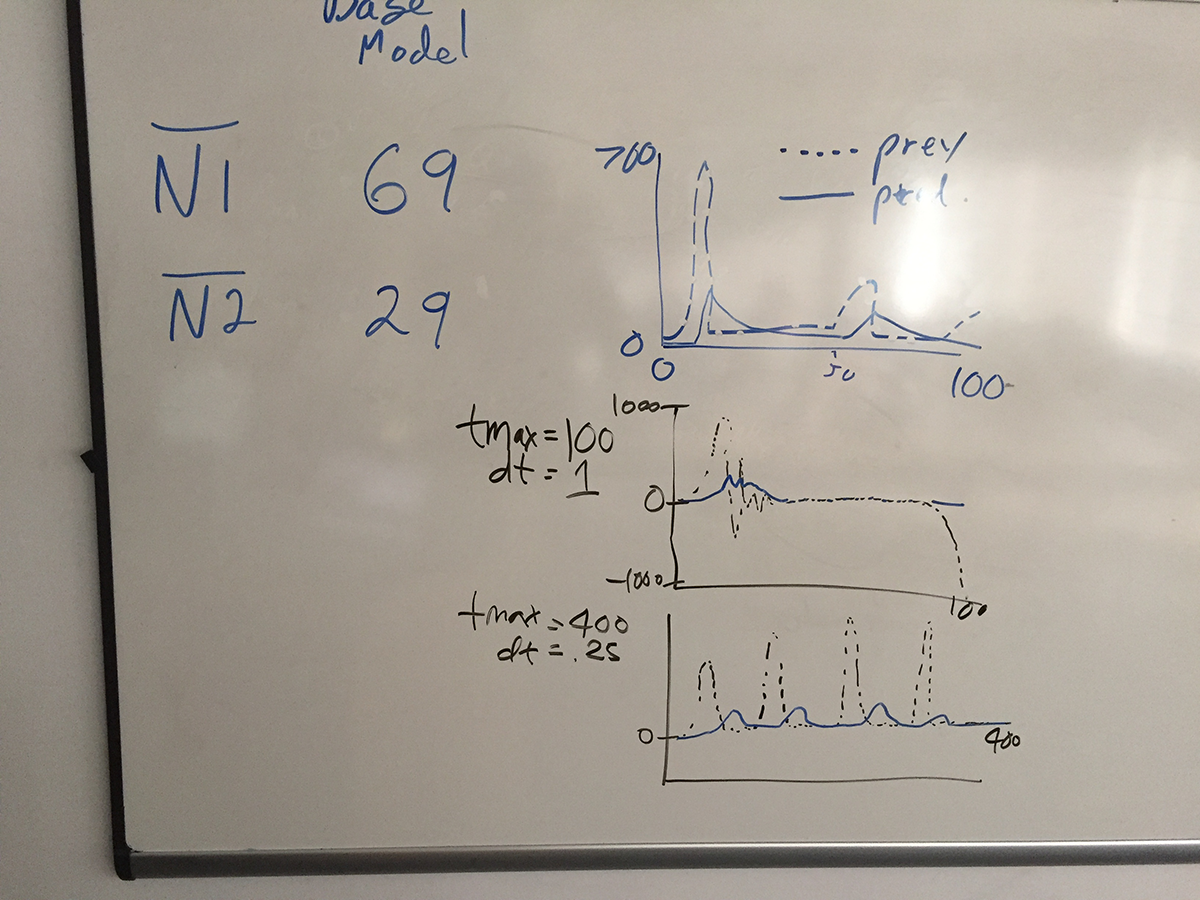Class on October 18 2018
Brian reminded the students of the value of using models like an NPZD model. We hope to use past experience to provide insight and predict future experience.
In order to be useful, model results have to be able to be computed in less time than the forecast duration. For example, weather forecasts for the next six hours
are usually computed within an hour or so. Brian provided an overview of considerations for developing models when considering costs involved beyond the generation
of the model: programmer time to encode in software, hardware costs and architectures to run models on, computer memory costs and architecturesf or saving inputs,
outputs, and results (intermediary and final).
Brian continued the discussion of model analysis based on the simple predator-prey models students considered last week. He provided background on the Euler method (developed in the 1800s) and pointed out how we had used the Euler method without explicit knowledge. There's an interesting scene from the movie Hidden Figures that centers on the Euler method being used in the Apollo missions planning process. The Euler method is a useful method for estimating the long-term behavior of the Lotka-Volterra equations. Brian pointed out that regarding precision, the error increases with the number of steps taken.
Brian then had students modify their Python Jupyter notebooks to add variables for time, timestep, and number of steps with which to iterate the ordinary linear equations. We added variables for t (time step duration), time (for each timestep), and jsteps (number of timesteps to run the equations to get to a tmax, max time). We eliminated the lines of code that added new predators and prey when their numbers fell below a minimum.
The resultant notebook provided the following plots given different values for timestep (variable t):

One take away is the awareness that too long a timestep can create estimation errors. And yet, too short a timestep can require unnecessary computational time and resources.
Results had been sketched out on the whiteboard, in order to incorporate thoughts into the interactive lecture, as seen here:

Lucie then gave a presentation regarding internship programs associated with the PODS program:

Students were told to pay attention to application task deadlines whenever a potential internship opportunity is announced by an organization. Students were told to play with the newest iteration of the Python notebook to gain a deeper acquaintance with what Python and modeling can provide to an anaylsis of natural phenomena.
Brian continued the discussion of model analysis based on the simple predator-prey models students considered last week. He provided background on the Euler method (developed in the 1800s) and pointed out how we had used the Euler method without explicit knowledge. There's an interesting scene from the movie Hidden Figures that centers on the Euler method being used in the Apollo missions planning process. The Euler method is a useful method for estimating the long-term behavior of the Lotka-Volterra equations. Brian pointed out that regarding precision, the error increases with the number of steps taken.
Brian then had students modify their Python Jupyter notebooks to add variables for time, timestep, and number of steps with which to iterate the ordinary linear equations. We added variables for t (time step duration), time (for each timestep), and jsteps (number of timesteps to run the equations to get to a tmax, max time). We eliminated the lines of code that added new predators and prey when their numbers fell below a minimum.
The resultant notebook provided the following plots given different values for timestep (variable t):

One take away is the awareness that too long a timestep can create estimation errors. And yet, too short a timestep can require unnecessary computational time and resources.
Results had been sketched out on the whiteboard, in order to incorporate thoughts into the interactive lecture, as seen here:

Lucie then gave a presentation regarding internship programs associated with the PODS program:

Students were told to pay attention to application task deadlines whenever a potential internship opportunity is announced by an organization. Students were told to play with the newest iteration of the Python notebook to gain a deeper acquaintance with what Python and modeling can provide to an anaylsis of natural phenomena.

